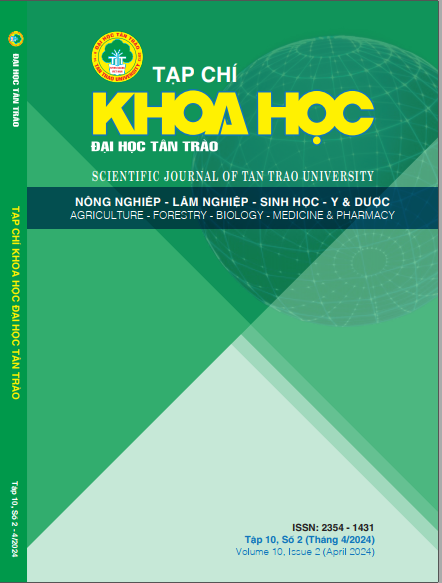EFFECT OF SOME TECHNOLOGICAL FACTORS IN THE PROCESS OF JAM FROM PINEAPPLE ADDED COCONUT CREAM
DOI:
https://doi.org/10.51453/2354-1431/2024/1142Abstract
Pineapple (Ananas comosus) is a nutritious tropical fruit often eaten as fresh or processed products such as pineapple juice, concentrated pineapple juice, and dried pineapple... Currently, pineapple puree products are not popular on the market and there has still not been complete research on the processing technology of this product. This study aimed to determine some technological parameters including coconut milk mixing ratio, additional citric acid content, additional pectin content, added sugar ratio, and appropriate concentration time to create products with the best sensory quality in terms of structure, color, smell, and taste. Factors include total soluble solids content (TSS) (pre-concentrate and post-concentrate), pH (pre-concentrate and post- concentrate), total organic acid content, and sensory evaluation were monitored in each experiment. According to the results, the ratio of mixing coconut cream (80/20), the content of added citric acid (0.4%), the added pectin content (0.7%), the ratio of added sugar (85/15), and the concentration-time (30 minutes) are suitable for processing this product with the best sensory quality.
Downloads
References
Bartolomew, Pilar Rupérez & Carmen Fúster. (1995). Pineapple fruit: morphological characteristics, chemical composition and sensory analysis of ReSpanish and Smooth cayenne cultivars. Food Chemistry, 53 (1):75-79.
Claudia Contini, Rocío Álvarez, Michael O’Sullivan, Denis Dowling, Sean Gargan & Frank Monahan. (2014). Effect of an active packaging with citrus extract on lipid oxidation and sensory quality of cooked turkey meat. Meat science, 96(3), 1171-1176.
Emmanuel Ohene Afoakwa, Joseph Ashong, Edmund Nartey & George Amponsah Annor. (2006). Effect of sugar, pectin and acid balance on the quality characteristics of pineapple (Ananas comosus) jam.
Dam Sao Mai, Nguyen Thi Hoang Yen & Bui Dang Khue. (2012). Food additives, Ho Chi Minh City National University Publishing House.
Faruque Hossain (2016). World pineapple production: An overview. African Journal of Food, Agriculture, Nutrition and Development, 16(4), 11443-11456.
Ha Duyen Tu (2010). Textbook of food sensory analysis and evaluation techniques. Science and Technology Publishing House.
Joy PP. (2010). Benefits and uses of pineapple. Pineapple Research Station (Kerala Agricultural University), Vazhakulam-686 670, Muvattupuzha, Ernakulam District, Kerala, India.
Maimunah Mohd Ali, Norhashila Hashim, Samsuzana Abd Aziz & Ola Lasekan. (2020). Pineapple (Ananas comosus): A comprehensive review of nutritional values, volatile compounds, health benefits, and potential food
products. Food Research International.
Martin Grootveld, Benita Percival, Sarah Moumtaz, Miles Gibson, Katy Woodason, Azeem Akhtar, Michael Wawire, Mark Edgar & Kerry Grootveld. (2021). Commentary: iconoclastic reflections on the ‘safety ’ of polyunsaturated fatty acid-rich culinary frying oils: some cautions regarding the laboratory analysis and dietary ingestion of lipid oxidation product toxins. Applied Sciences, 11(5), 2351.
Melkam Bekele, Neela Satheesh, & Sadik Jemal Awol. (2020). Screening of Ethiopian mango cultivars for suitability for preparing jam and determination of pectin, sugar, and acid effects on physico-chemical and sensory properties of mango jam. Scientific African, 7, e00277.
Minal Mhatre, Jai Tilak-Jain, Strayo De Mhatre & Devasagayam Thomas Paul Asir. (2009). Evaluation of the antioxidant activity of non- transformed and transformed pineapple: A comparative study. Food and Chemical Toxicology, 47(11), 2696-2702.
Nguyen Dang Duc. (2008). Analytical Chemistry Textbook. Thai Nguyen University Publishing House.
Nguyen Phu Duc., Le Thi Hong Anh. (2021).Food Additives Textbook. National University Publishing House, Ho Chi Minh City.
Ngo Xuan Manh., Lai Thi Ngoc Ha., Vu Thi Hang. (2020). Food Chemistry Textbook. Agricultural Academy Publishing House.
PC Njoku, AA Ayuk & CV Okoye. (2011). Temperature effects on vitamin C content in citrus fruits. Pakistan Journal of Nutrition, 10(12), 1168-1169.
Prasenjit Debnath, Prasanta Dey, Abhijit Chanda & Tejendra Bhakta (2012). A Survey on Pineapple and its medicinal value. Scholars Academic Journal of Pharmacy (SAJP). 1(1).
Robert Cotton, Paul Rebers, Maudru & Guy Rorabaugh. (1955). The role of sugar in the food industry.
Santanu Basu & Shivhare. (2010). Rheological, textural, micro-structural and sensory properties of mango jam. Journal of Food Engineering, 100(2), 357-365.
Sourav Garg., Payel Ghosh., Sandeep Singh Rana., Rama Chandra Pradhan .(2019). Preparation and quality evaluation of nutritionally enriched jam made from blends of Indian blackberryand other fruits. International Journal of Fruit Science, 19(1), 29-44.
Teklu Chalchisa, Adamu Zegeye, Belay Dereje & Yohannes Tolesa. (2022). Effect of Sugar, Pectin, and Processing Temperature on the Qualities of Pineapple Jam. International Journal of Fruit Science, 22(1), 711-724.
Tran Thi Dinh. (2016). Optimizing Technological Parameters for Pectin Extraction from Dragon Fruit Peels. Vietnam Journal of Agricultural Sciences, 14(4): 645-653.
Downloads
Published
How to Cite
Issue
Section
License

This work is licensed under a Creative Commons Attribution-ShareAlike 4.0 International License.
All articles published in SJTTU are licensed under a Creative Commons Attribution-ShareAlike 4.0 International (CC BY-SA) license. This means anyone is free to copy, transform, or redistribute articles for any lawful purpose in any medium, provided they give appropriate attribution to the original author(s) and SJTTU, link to the license, indicate if changes were made, and redistribute any derivative work under the same license.
Copyright on articles is retained by the respective author(s), without restrictions. A non-exclusive license is granted to SJTTU to publish the article and identify itself as its original publisher, along with the commercial right to include the article in a hardcopy issue for sale to libraries and individuals.
Although the conditions of the CC BY-SA license don't apply to authors (as the copyright holder of your article, you have no restrictions on your rights), by submitting to SJTTU, authors recognize the rights of readers, and must grant any third party the right to use their article to the extent provided by the license.


